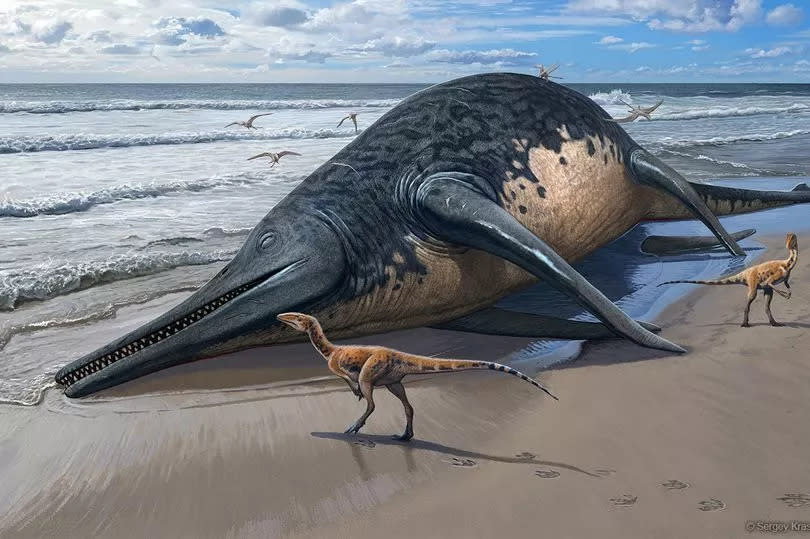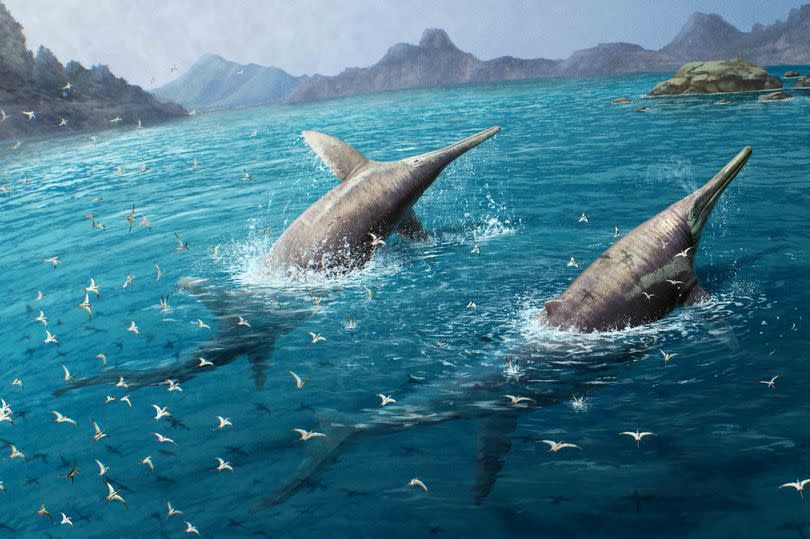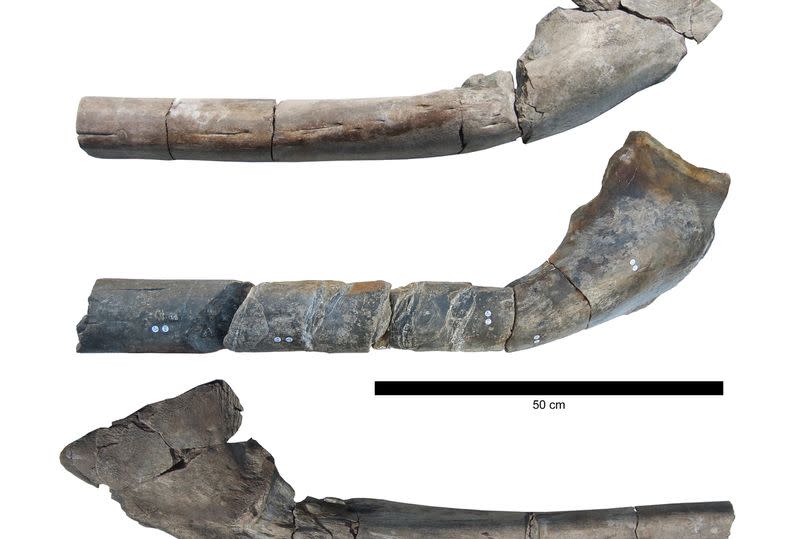Experts have announced that a fossil found on a beach in the Bristol Channel is the giant jawbone of a new species of enormous dinosaur, which could be the largest marine reptile ever found in Britain.
The fossil is more than two meters long and, incredibly, has been identified by experts at the University of Bristol as the jawbone of a creature so large it would have been more than 25 meters long.
It was found in the eroding cliffs at Blue Anchor on the Bristol Channel coast in Somerset by a father and daughter from Braunton in Devon called Justin and Ruby Reynolds – and is the culmination of an eight-year mission that is part treasure hunt and part gigantic mission. prehistoric puzzle.
Read more: New exhibition reveals fossil of a sea monster that bit off more than it could chew
Read more: Jurassic Coast fossil finders must adhere to new rules – or face legal action
The first piece of this gigantic creature’s jaw was found further up the coast near Lilstock in May 2016 by a seasoned fossil collector named Paul de la Salle. Its discovery was tantalizing – because the experts knew it meant there might be more fossilized remains of other specimens of the creature nearby. Sure enough, in May 2020, Justin Reynolds and his daughter Ruby, who was only 11 at the time, found the first piece of giant bone at Blue Anchor. Together they searched the area and found more pieces.
Finally, the final piece to complete the puzzle was found by Ruby in October 2022, and now for the first time, experts at the University of Bristol have managed to put it all together and formally identify it as a new species of giant ichthyosaur . a marine reptile that could have been 25 meters long – the length of two double-decker buses lined up behind each other – that once swam in the seas of what eventually became the Bristol Channel millions of years ago.
Justin and Ruby first brought their find to Dr. Dean Lomax, an 1851 Research Fellow at the University of Bristol, one of the world’s leading experts on ichthyosaurs. He contacted Paul de Salle again and together with the university team they embarked on what he described as a ‘very exciting’ discovery.
“I was surprised by the find,” he says. “In 2018, my team, including Paul de la Salle, studied and described Paul’s gigantic jawbone and we had hoped that one day another would come to light.


“This new specimen is more complete, better preserved and shows that we now have two of these giant bones (called a surangular) that have a unique shape and structure. “I got very excited, to say the least,” he added.
Thinking that they might have found something new, the college team, along with Paul, family members and Justin and Ruby, kept going back to Blue Anchor to see if they could find more – and they did, and they were able to fit all the pieces. together.
“When Ruby and I found the first two pieces, we were very excited because we realized this was something important and unusual,” said proud father Justin. “When I found the back part of the jaw I was very happy because that is one of the defining parts of Paul’s earlier discovery.”
The last piece of bone was recovered in October 2022, and now the discovery has been verified, assessed and confirmed as a new species of ichthyosaur – because two different creatures have been found close together that differ from previous discoveries. They have named it ichthyosaur severnensis, which means ‘giant fish lizard of the River Severn’.
The creature is thought to have been swimming about 202 million years ago, at the end of the Triassic period; the giant ichthyosaur is said to have been swimming in the seas at the same time that dinosaurs were walking on land. The layer of fossils in which the giant Severn lizard was found also reveals something else: the rocks above record a global catastrophe known as the Late Triassic global mass extinction event. Something happened that caused many dinosaurs, including giant ichthyosaurs from this period, to become extinct.


“Today these bones represent the very last of their kind,” said a spokesperson for the University of Bristol. “Ichthyotitan is not the world’s first giant ichthyosaur, but the discoveries of De la Salles and Reynolds are unique among those known to science. These two bones appear roughly 13 million years after their last geological relatives, including Shonisaurus sikanniensis from British Columbia, Canada, and Himalayasaurus tibetensis from Tibet, China,” he added.
Dr. Lomax said he was impressed that the father and daughter realized what they had found when they found it, and that there would be more to discover. “I was very impressed that Ruby and Justin correctly identified the discovery as a huge jawbone of an ichthyosaur. They recognized that it was consistent with what we described in 2018,” he said.
“I asked them if they would like to join my team to study and describe this fossil, including its naming. They seized their chance. For Ruby in particular, she is now a published scientist who has not only found a species of giant prehistoric reptile, but also helped name it. There probably aren’t many 15 year olds who can say that! Maybe a Mary Anning in the making,” Dr. Lomax added.
Now fifteen, Ruby said she was happy to have discovered a new species of ichthyosaur. “It was so cool to discover part of this giant ichthyosaur,” she said. “I am very proud to have played a role in a scientific discovery like this.”
To get confirmation that this is the discovery of a new species of ichthyosaur, the Bristol team brought in researchers from around the world to do the science. Marcello Perillo, from the University of Bonn in Germany, took core samples from the new bones, examined the internal structures and confirmed the origins of the ichthyosaur – his research showed that the animal was still growing when it died.
Meanwhile, a researcher from a museum in Orlando, Florida, also became involved. “Every fossil fan dreams of an experience like Ruby’s – and she deserves all the joy and excitement,” said Jimmy Waldron of the DWABA Museum.


“It is truly special to be the first human eyes to look at this incredible fossil after 202 million years. Justin sets a great example by supporting his daughter’s interests in science and paleontology. Fossils like Ichthyotitan provide a glimpse into unknown chapters of life on Earth, and it is our responsibility to share these wonders and the processes with the public,” he added.
Dr. Lomax said there was more to be found. “This investigation has been going on for almost eight years. “It’s quite remarkable to think that giant ichthyosaurs the size of blue whales swam in the oceans surrounding the British Triassic,” he said.
“These jawbones provide tantalizing evidence that a complete skull or skeleton of one of these giants may one day be found. You never know,” he added.